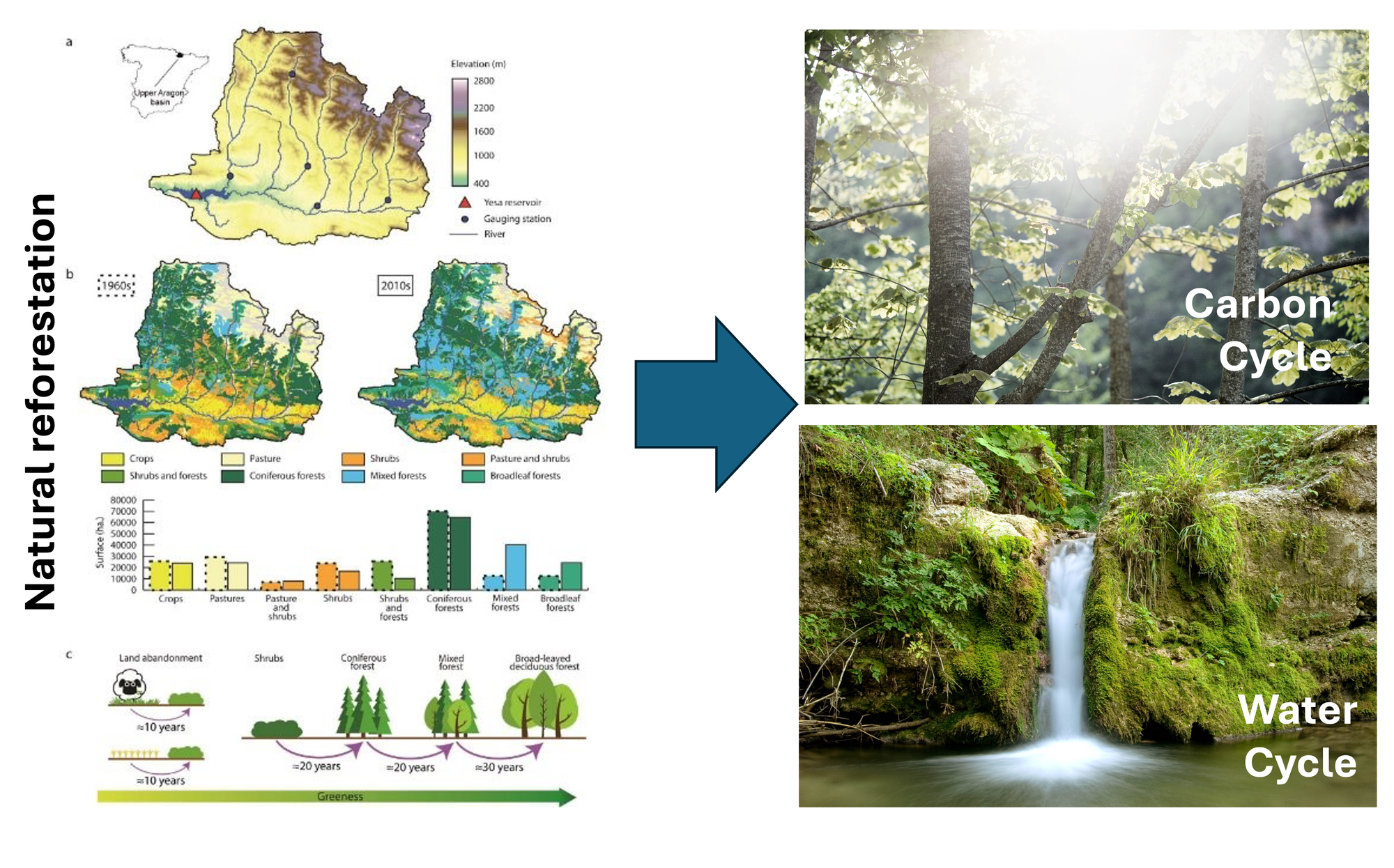The GLANCE (AGricultural Land AbandoNment and ClimatE change) project explores the socio-ecohydrological interconnections between people, water, and forests in the Mediterranean region. It focuses on understanding how agricultural land abandonment and climate change, since the end of World War II, have influenced forest carbon dynamics, as well as water and energy cycles. The project leverages satellite climate data records from the ESA Climate Change Initiative to uncover these impacts.
Background
In recent decades, the Mediterranean region (MR) has emerged as a critical hotspot for both climate change (Giorgi, 2006; IPCC, 2021) and land abandonment (Herrando et al., 2016; Jiménez-Olivencia et al., 2021). Only in Europe, approximately 120 million hectares of land have been abandoned, primarily due to socio-economic factors such as rural migration to areas offering better economic opportunities - a trend particularly pronounced in the Mediterranean.
Following World War II, traditional agro-pastoral activities in the Mediterranean began to decline, driven by significant socio-economic shifts and the subsequent economic boom. As a result, rural areas and grazing lands in the Apennines and other Mediterranean mountain regions - including Italy, Spain, France, and Greece - have experienced widespread natural reforestation (Mottet et al., 2018). This, along with a significant rise in atmospheric evaporative demand due to climate change has triggered complex and poorly understood effects on the carbon, water, and energy cycles that will be studied by GLANCE.

Project aims and objectives
The primary goal of GLANCE is to leverage satellite data records of Essential Climate Variables generated through the European Space Agency's Climate Change Initiative (ESA CCI) for the quantification of the effects of climate change and land abandonment on forest carbon dynamics, water and energy cycles in the Mediterranean Region.
GLANCE aims at answering the following research questions:
- How much, where and what type of Mediterranean forests have expanded in the past couple of decades?
- How has forest expansion due to land abandonment and climate change impacted water, energy and carbon cycles especially during major drought events?
- Which is the sensitivity of a change in runoff, groundwater recharge, evaporation, net and gross primary productivity, water use efficiency to changes in forest cover under land abandonment and climate change?
Project plans
GLANCE will achieve its objectives through:
- Utilizing past and ongoing ESA CCI and other ESA initiatives within an integrated framework to analyse long-term observations (at least 30 years) of forest carbon and water–energy cycle dynamics at the MR.
- Employing tools, data and methods to accurately assess the uncertainties associated with each ESA CCI dataset and derived products utilizing (i) collected benchmark data from the GLANCE database, (ii) error propagation techniques (e.g., Montecarlo approaches), Triple Collocation techniques and iii) cross- comparison among the existing observational products and reanalyses.
- Employing state-of-the-art trend analysis, drought indices, and climate elasticity to uncover the impacts of land use changes on forest carbon and water cycle dynamics over the past three decades in the MR.
The GLANCE project consortium consists of the following partners:
- CNR, CONSIGLIO NAZIONALE DELLE RICERCHE (CNR-IRPI) - science leader (Christian Massari, Luca Ciabatta, Marco Donnini, Massimo Melillo, Mauro Rossi, Angelica Tarpanelli)
- POLITECNICO DI MILANO (POLIMI) - project manager (Chiara Corbari, Maria Antonia Brovelli, Daniele Oxoli, Nicola Paciolla, Pedro Torralbo Muñoz)
- Vienna University of Technology (TU WIEN) - (Wouter Dorigo, Pierre Laluet, Ruxandra Zotta)
- Ghent University (UGhent) - (Diego G. Miralles, Oscar M. Baez- Villanueva)
- Consejo Superior de Investigaciones Científicas (CSIC -IPE), Instituto Pirenaico de Ecología (Sergio Vicente Serrano, Estela Nadal-Romero)

Science Leader - Christian Massari
Project Manager - Chiara Corbari
ESA Technical Officer - Clément Albergel
Latest news & events

CCI colocation & CMUG integration meeting 2026
Annual gathering of the CCI community for ESA programme updates, scientific progress, and forward-looking discussions.
Mehr erfahren
New Position: Junior Professional in AI for Climate Science
Opportunity for early-career Artificial Intelligence talent to join ESA’s Actionable Climate Information Section
Mehr erfahren
Working for ESA: procurement and proposal submission process
An Introduction to ESA Star - ESA's System for Tendering and Registration
Mehr erfahren
ESA at COP29
ESA is participating in COP29 to highlighting satellites' role in tackling climate change
Mehr erfahren






